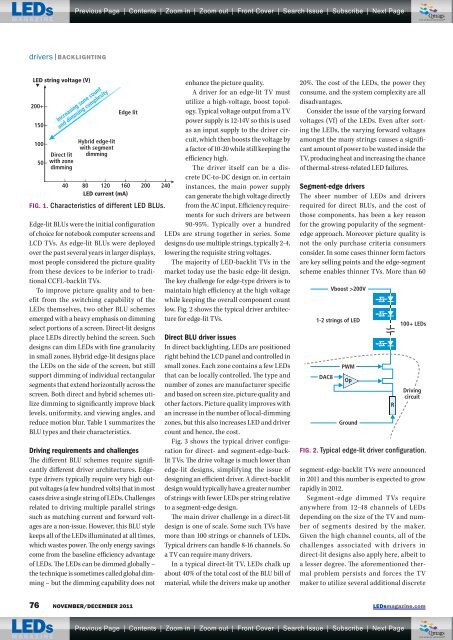Modules - Beriled
Modules - Beriled
Modules - Beriled
Create successful ePaper yourself
Turn your PDF publications into a flip-book with our unique Google optimized e-Paper software.
Previous Page | Contents | Zoom in | Zoom out | Front Cover | Search Issue | SubscribeqMqM | Next PageqqM qMMQmagsTHE WORLD’S NEWSSTAND ®drivers | BACKLIGHTINGLED string voltage (V)200+15010050Increasing zone countand dimming complexityDirect litwith zonedimming40Hybrid edge-litwith segmentdimmingEdge lit80 120 160LED current (mA)200FIG. 1. Characteristics of different LED BLUs.Edge-lit BLUs were the initial configurationof choice for notebook computer screens andLCD TVs. As edge-lit BLUs were deployedover the past several years in larger displays,most people considered the picture qualityfrom these devices to be inferior to traditionalCCFL-backlit TVs.To improve picture quality and to benefitfrom the switching capability of theLEDs themselves, two other BLU schemesemerged with a heavy emphasis on dimmingselect portions of a screen. Direct-lit designsplace LEDs directly behind the screen. Suchdesigns can dim LEDs with fine granularityin small zones. Hybrid edge-lit designs placethe LEDs on the side of the screen, but stillsupport dimming of individual rectangularsegments that extend horizontally across thescreen. Both direct and hybrid schemes utilizedimming to significantly improve blacklevels, uniformity, and viewing angles, andreduce motion blur. Table 1 summarizes theBLU types and their characteristics.Driving requirements and challengesThe different BLU schemes require significantlydifferent driver architectures. Edgetypedrivers typically require very high outputvoltages (a few hundred volts) that in mostcases drive a single string of LEDs. Challengesrelated to driving multiple parallel stringssuch as matching current and forward voltagesare a non-issue. However, this BLU stylekeeps all of the LEDs illuminated at all times,which wastes power. The only energy savingscome from the baseline efficiency advantageof LEDs. The LEDs can be dimmed globally –the technique is sometimes called global dimming– but the dimming capability does notenhance the picture quality.A driver for an edge-lit TV mustutilize a high-voltage, boost topology.Typical voltage output from a TVpower supply is 12-14V so this is usedas an input supply to the driver circuit,which then boosts the voltage bya factor of 10-20 while still keeping theefficiency high.The driver itself can be a discreteDC-to-DC design or, in certain240 instances, the main power supplycan generate the high voltage directlyfrom the AC input. Efficiency requirementsfor such drivers are between90-95%. Typically over a hundredLEDs are strung together in series. Somedesigns do use multiple strings, typically 2-4,lowering the requisite string voltages.The majority of LED-backlit TVs in themarket today use the basic edge-lit design.The key challenge for edge-type drivers is tomaintain high efficiency at the high voltagewhile keeping the overall component countlow. Fig. 2 shows the typical driver architecturefor edge-lit TVs.Direct BLU driver issuesIn direct backlighting, LEDs are positionedright behind the LCD panel and controlled insmall zones. Each zone contains a few LEDsthat can be locally controlled. The type andnumber of zones are manufacturer specificand based on screen size, picture quality andother factors. Picture quality improves withan increase in the number of local-dimmingzones, but this also increases LED and drivercount and hence, the cost.Fig. 3 shows the typical driver configurationfor direct- and segment-edge-backlitTVs. The drive voltage is much lower thanedge-lit designs, simplifying the issue ofdesigning an efficient driver. A direct-backlitdesign would typically have a greater numberof strings with fewer LEDs per string relativeto a segment-edge design.The main driver challenge in a direct-litdesign is one of scale. Some such TVs havemore than 100 strings or channels of LEDs.Typical drivers can handle 8-16 channels. Soa TV can require many drivers.In a typical direct-lit TV, LEDs chalk upabout 40% of the total cost of the BLU bill ofmaterial, while the drivers make up another20%. The cost of the LEDs, the power theyconsume, and the system complexity are alldisadvantages.Consider the issue of the varying forwardvoltages (Vf) of the LEDs. Even after sortingthe LEDs, the varying forward voltagesamongst the many strings causes a significantamount of power to be wasted inside theTV, producing heat and increasing the chanceof thermal-stress-related LED failures.Segment-edge driversThe sheer number of LEDs and driversrequired for direct BLUs, and the cost ofthose components, has been a key reasonfor the growing popularity of the segmentedgeapproach. Moreover picture quality isnot the only purchase criteria consumersconsider. In some cases thinner form factorsare key selling points and the edge-segmentscheme enables thinner TVs. More than 60Vboost >200V1-2 strings of LEDDAC8PWMOpGroundR100+ LEDsDrivingcircuitFIG. 2. Typical edge-lit driver confi guration.segment-edge-backlit TVs were announcedin 2011 and this number is expected to growrapidly in 2012.Segment-edge dimmed TVs requireanywhere from 12-48 channels of LEDsdepending on the size of the TV and numberof segments desired by the maker.Given the high channel counts, all of thechallenges associated with drivers indirect-lit designs also apply here, albeit toa lesser degree. The aforementioned thermalproblem persists and forces the TVmaker to utilize several additional discrete76 NOVEMBER/DECEMBER 2011 LEDsmagazine.comPrevious Page | Contents | Zoom in | Zoom out | Front Cover | Search Issue | SubscribeqMqM qMM MQmags| Next Page q qTHE WORLD’S NEWSSTAND ®
















